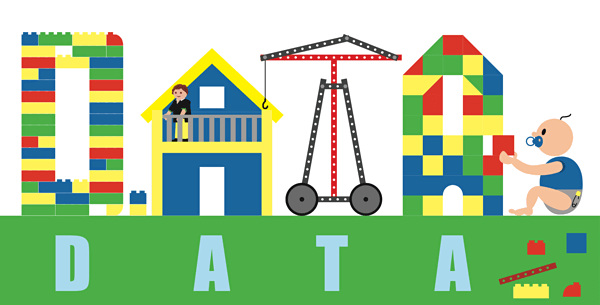Working with data: a toy metaphor
Using metaphors is dangerous. Metaphors do not describe reality, but are a tool to create insight into complex problems. I have an ambivalent relationship with metaphors. People tend to run away with them and stretch the simplification, instead of using it as an entry into discussing the real complexities. Notwithstanding, this short article is making use of one.

What is asked of an organisation when working with data?
Explaining the conditions imposed by working with data is difficult, even in 2020. It is almost as if people freeze when the subject is addressed. It is not easy, due to the complex technology involved. Users of information are often clueless to what the data delivering the information represents and are unaware of their lacking skills when working with data. The message that working with data requires people with different skillsets to collaborate continuously remains often unheard. Working with data is a process.
Trying to explain that just making data available is not sufficient is cumbersome. In order to harvest value out of information, you need to put a lot of energy into keeping your data landscape neat and tight, and it starts with the capture of data.
People are conscious of data quality being an issue. Managers are bombarded with the message that data governance is really important. But cause and effect is rarely understood, if you observe the flow of data in an average organisation. As a result, people struggle to understand what they must do to make and keep their data landscape productive. To duck the problems emerging from this lack of understanding, the message about the lousy state of data governance is wilfully ignored.
The metaphor
Imagine the data landscape of your organisation as a children’s room full of toys. The intention is to clear away the toys that are not used, but everyone knows that in reality the toys are scattered everywhere in the room.
Data is sometimes a firetruck or a barbie doll, a premeditated object with a clear function, but more often it is like lego, playmobil or mecano.
If you want to build something with lego and all toys, including the lego pieces, are scattered across the room, like a bomb has exploded, instead of all the lego stacked in a single storage box, then it will take much more energy and effort to build something out of lego. This is what you observe in most organisations time and time again.
Can technology fix this for us?
Technology is the storage boxes. They can only be of use if you have the discipline to clean up. Working with data is not toy management. Working with data is the children playing with the toys.
You can add more storage boxes and hope it will trigger the cleaning up of toys, but you know it is wishful thinking. You have to agree on which toys go in what box and you have to enforce that agreement: lego with lego, playmobil with playmobil, dolls on the shelf and cars in the closet.
Alternatively, you can buy a big storage box and throw all dolls, cars, lego, playmobil and mecano into it. The room looks tidy, but good luck if you want to build a firetruck out of lego.
What are algorithms?
Algorithms, and other information products like dashboards, are the manual included with lego, playmobil or mecano. Sometimes, you need to follow the instructions to the letter to build something, sometimes you let the creativity of a child float freely when building something with lego.
When children play, they create a world in which a barbie doll, the firetruck and things they build with lego together tell a story. The story is what only we, humans, can invent. Technology will not fabricate that story for you. If that is your expectation of technology, you will be disappointed over and over again. It is the unimaginative child who will ask for new toys all the time and will not play with it because the new toy frustrates the child. Sometimes it is the spoilt child that will whine for the toys that the next door kid has and never looks at the toys it already has.
If you think that this part of the metaphor is childish or pedantic, then think back to the discussions you have.
Where goes the toy metaphor awry?
There is an avalanche of new lego bricks, barbie dolls and playmobil dolls. There are children who will jump to their feet while playing and who start to jell they want to play something different.
Going awry? I think everyone can point out the screaming children in their organisation. I think at some level we are all screaming children who want to change the game continuously and who get mad because other children cannot convert the lego firetruck into a plane fast enough.
The methaphor and reality
Everyone can understand this article. Replace the words toy, storage box and manual with data, data lakes and AI, and you find yourself in a discussion where people start to frown, cling to techno-religions and voice opinions about working with data while not having first-hand experience of building something with lego.
And yet, it is simple: working with data is like children who have to play together with the toys available to them and who have to invent a new play scenario every day. This will go smoothly if you organise the toys in the right storage box, especially when new toys arrive. That way, you can keep complexity low.
